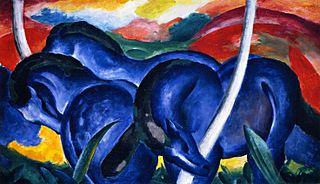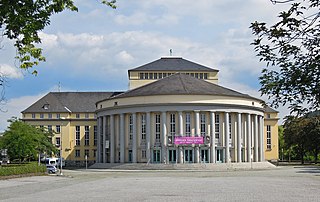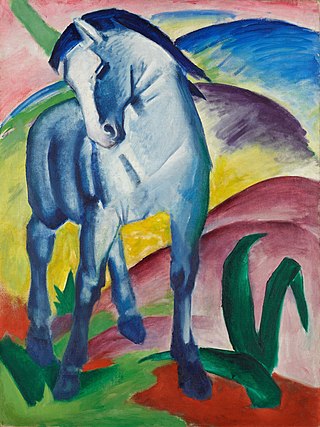
Saarland is a state of Germany in the southwest of the country. With an area of 2,570 km2 (990 sq mi) and population of 990,509 in 2018, it is the smallest German state in area apart from the city-states of Berlin, Bremen, and Hamburg, and the smallest in population apart from Bremen. Saarbrücken is the state capital and largest city; other cities include Neunkirchen and Saarlouis. Saarland is mainly surrounded by the department of Moselle in France to the west and south and the neighboring state of Rhineland-Palatinate in Germany to the north and east; it also shares a small border about 8 kilometres long with the canton of Remich in Luxembourg to the northwest.

Franz Moritz Wilhelm Marc was a German painter and printmaker, one of the key figures of German Expressionism. He was a founding member of Der Blaue Reiter, a journal whose name later became synonymous with the circle of artists collaborating in it.

Sankt Wendel is a town in northeastern Saarland. It is situated on the river Blies 36 km northeast of Saarbrücken, the capital of Saarland, and is named after Saint Wendelin of Trier. According to a survey by the German Association for Housing, Town Planning and Land Use Regulation, St. Wendel is known to be one of the wealthiest regions in Germany, behind Starnberg in Bavaria.

Blue Horses is a 1911 painting by German painter and printmaker Franz Marc (1880–1916).

The Lenbachhaus is a building housing the Städtische Galerie art museum in Munich's Kunstareal.

Saarland Police is a state law-enforcement agency in Saarland, Germany. It is subordinated to the Saar Ministry of the Interior, Urban Development and Sports.

The Saarland Museum is an art museum in Saarbrücken, Saarland, Germany. It is spread across three sites, each with a different specialism.

The Saarbrücken–Trier railway, known in German as the Saarstrecke in the German states of Rhineland-Palatinate and Saarland. It connects Saarbrücken and Trier. It was opened in 1858 and 1860 and is one of the oldest railways in Germany.
Abenteuermuseum (Saarbrücken) is a former museum in Saarland, Germany, which was founded by the deceased Heinz Rox-Schulz.

The Tower of Blue Horses is a 1913 oil painting by the German Expressionist artist Franz Marc. It has been called one of his best works, but went missing in 1945.

Christoph Georg Hartmann is a German politician who is a member of the Free Democratic Party (FDP). From November 2009 until January 2012, he was the secretary to the Minister-president of Saarland and the Saarland Minister for Economy and Science.

Fate of the Animals is a painting by Franz Marc created in 1913. It is oil on canvas. This work contrasts most of Marc's other works by presenting animals in a brutal way rather than depicting them in a peaceful manner. Marc's strong ties with animals as his subjects remains uncertain, but it is predicted to stem from his childhood dog. Fate of the Animals remains one of Marc's most famous pieces and displays Der Blaue Reiter style that he co-founded with Wassily Kandinsky. The painting currently resides in the Kunstmuseum in Basel, Switzerland.

Arvid Boecker in Wuppertal) is a German painter and curator. He is a representative of concrete art and focuses on color field painting.

Theater Saarbrücken, officially Saarländisches Staatstheater since 1971, is the state theatre of Saarland in its capital Saarbrücken, Germany. It has several divisions and offers annually around 30 new productions in around 700 events for more than 200,000 people. Its venues are Großes Haus, Alte Feuerwache, Congresshalle and sparte4. While theatre in Saarbrücken has a long history, the present main venue was completed in 1938, with plans commissioned by the Nazi regime.

The Friendship Bridge is a bridge which crosses the Saar river, south of Saarbrücken, and links the Saarland municipality of Kleinblittersdorf with the Lorraine commune of Grosbliederstroff.

The Hochschule der Bildenden Künste Saar or HBKsaar, is an art and design university in the German State of Saarland.

Andrea Neumann was a German visual artist and educator. She is one of the most important artists of the Saarland region. She is known for her abstract paintings.

Blue Horse I is an oil painting by Franz Marc completed in 1911. It is one of the painter's most famous works and is part of the collection of the Städtische Galerie im Lenbachhaus in Munich. The painting was part of several exhibitions that Franz Marc and fellow Russian painter Wassily Kandinsky presented to the public under the name Der Blaue Reiter from late 1911 until 1914.

Horses in Landscape is a watercolour with pencil on paper by the German painter Franz Marc, executed in 1911. It is probably a study, which was thought to be lost, for the painting Blue Horses (1911). The painting became known worldwide on the occasion of the Schwabing art discovery in November 2013. It was one of the first eleven works to be shown at a press conference by the Augsburg public prosecutor. The small-format work measures 12.1 × 19.6 cm.

Franz Josef Kohl-Weigand was a German businessman, art collector and philanthropist.



















